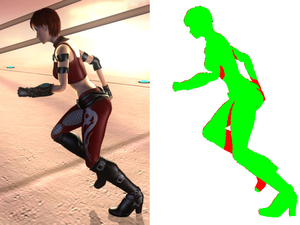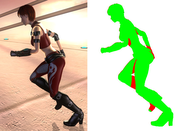Information
- Publication Type: Journal Paper (without talk)
- Workgroup(s)/Project(s):
- Date: December 2012
- ISSN: 1467-8659
- Journal: Computer Graphics Forum
- Number: 8
- Volume: 31
- Pages: 2378 – 2408
- Keywords: remote rendering; sampling, perception-based rendering, occlusion culling, non-photo-realistic rendering, level-of-detail, large data visualization, image-based rendering, global illumination, frame interpolation, anti-aliasing, shadows, streaming, temporal coherance, upsampling
Abstract
Nowadays, there is a strong trend towards rendering to higher-resolution displays and at high frame rates. This development aims at delivering more detail and better accuracy, but it also comes at a significant cost. Although graphics cards continue to evolve with an ever-increasing amount of computational power, the speed gain is easily counteracted by increasingly complex and sophisticated shading computations. For real-time applications, the direct consequence is that image resolution and temporal resolution are often the first candidates to bow to the performance constraints (e.g., although full HD is possible, PS3 and XBox often render at lower resolutions).In order to achieve high-quality rendering at a lower cost, one can exploit temporal coherence (TC). The underlying observation is that a higher resolution and frame rate do not necessarily imply a much higher workload, but a larger amount of redundancy and a higher potential for amortizing rendering over several frames. In this survey, we investigate methods that make use of this principle and provide practical and theoretical advice on how to exploit temporal coherence for performance optimization. These methods not only allow incorporating more computationally intensive shading effects into many existing applications, but also offer exciting opportunities for extending high-end graphics applications to lower-spec consumer-level hardware. To this end, we first introduce the notion and main concepts of TC, including an overview of historical methods. We then describe a general approach, image-space reprojection, with several implementation algorithms that facilitate reusing shading information across adjacent frames. We also discuss data-reuse quality and performance related to reprojection techniques. Finally, in the second half of this survey, we demonstrate various applications that exploit TC in real-time rendering.
Additional Files and Images
Weblinks
BibTeX
@article{SCHERZER-2012-TCM,
title = "Temporal Coherence Methods in Real-Time Rendering",
author = "Daniel Scherzer and Lei Yang and Oliver Mattausch and Diego
Nehab and Pedro V. Sander and Michael Wimmer and Elmar
Eisemann",
year = "2012",
abstract = "Nowadays, there is a strong trend towards rendering to
higher-resolution displays and at high frame rates. This
development aims at delivering more detail and better
accuracy, but it also comes at a significant cost. Although
graphics cards continue to evolve with an ever-increasing
amount of computational power, the speed gain is easily
counteracted by increasingly complex and sophisticated
shading computations. For real-time applications, the direct
consequence is that image resolution and temporal resolution
are often the first candidates to bow to the performance
constraints (e.g., although full HD is possible, PS3 and
XBox often render at lower resolutions). In order to
achieve high-quality rendering at a lower cost, one can
exploit temporal coherence (TC). The underlying observation
is that a higher resolution and frame rate do not
necessarily imply a much higher workload, but a larger
amount of redundancy and a higher potential for amortizing
rendering over several frames. In this survey, we
investigate methods that make use of this principle and
provide practical and theoretical advice on how to exploit
temporal coherence for performance optimization. These
methods not only allow incorporating more computationally
intensive shading effects into many existing applications,
but also offer exciting opportunities for extending high-end
graphics applications to lower-spec consumer-level hardware.
To this end, we first introduce the notion and main concepts
of TC, including an overview of historical methods. We then
describe a general approach, image-space reprojection, with
several implementation algorithms that facilitate reusing
shading information across adjacent frames. We also discuss
data-reuse quality and performance related to reprojection
techniques. Finally, in the second half of this survey, we
demonstrate various applications that exploit TC in
real-time rendering. ",
month = dec,
issn = "1467-8659",
journal = "Computer Graphics Forum",
number = "8",
volume = "31",
pages = "2378--2408",
keywords = "remote rendering; sampling, perception-based rendering,
occlusion culling, non-photo-realistic rendering,
level-of-detail, large data visualization, image-based
rendering, global illumination, frame interpolation,
anti-aliasing, shadows, streaming, temporal coherance,
upsampling",
URL = "https://www.cg.tuwien.ac.at/research/publications/2012/SCHERZER-2012-TCM/",
}


